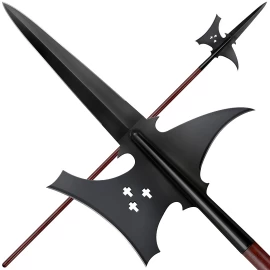Halberds
The halberd was cheap to produce and very versatile in battle. As the halberd was eventually refined, its point was more fully developed to allow it to better deal with spears and pikes (also able to push back approaching horsemen), as was the hook opposite the axe head, which could be used to pull horsemen to the ground.
Filter products
Halberds
A halberd (also called halbert or Swiss voulge) is a two-handed pole weapon that came to prominent use during the 14th and 15th centuries. Possibly the word halberd comes from the German words Halm (staff), and Barte (axe) - in modern-day German, the weapon is called Hellebarde. The halberd consists of an axe blade topped with a spike mounted on a long shaft. It always has a hook or thorn on the back side of the axe blade for grappling mounted combatants. It is very similar to certain forms of the voulge in design and usage. The halberd was 1.5 to 1.8 metres (5 to 6 feet) long.












